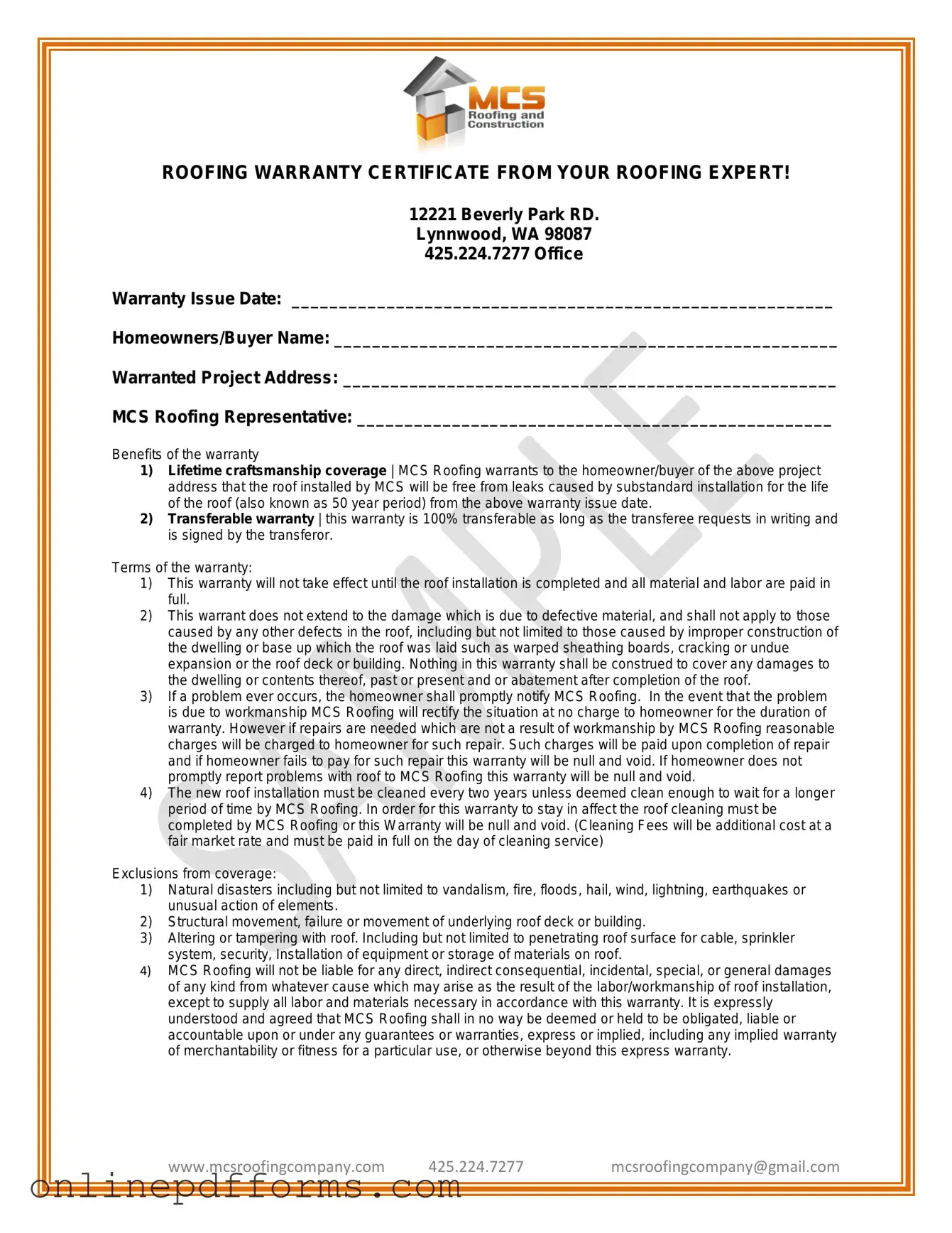The Roofing Warranty Certificate shares similarities with a Homeowner's Insurance Policy. Both documents aim to protect homeowners from unexpected financial burdens due to specific incidents. A homeowner's insurance policy typically covers a range of damages, including those caused by natural disasters, theft, or accidents. However, while the insurance policy provides broader coverage, the Roofing Warranty Certificate specifically focuses on workmanship and installation issues, ensuring that the roof remains leak-free due to improper installation for a defined period. This makes the warranty a more targeted form of protection compared to the general nature of homeowner's insurance.
For homeowners dealing with various warranties, understanding the nuances of each type is essential to ensure comprehensive protection. Whether it's the Home Warranty Certificate or the Manufacturer’s Product Warranty, knowing what they cover helps in making informed decisions. When it comes to vehicles, having proper documentation is equally crucial; thus, it's advisable to look into Vehicle Bill of Sale Forms to facilitate smooth transfers of ownership.
Another document that resembles the Roofing Warranty Certificate is a Manufacturer's Warranty for roofing materials. This warranty is issued by the manufacturer of the roofing materials and guarantees that the products will perform as expected for a certain period. Like the Roofing Warranty Certificate, it provides assurance to the homeowner that the materials used in their roofing system are free from defects. However, the key difference lies in the scope of coverage; while the manufacturer's warranty covers material defects, the Roofing Warranty Certificate focuses on the workmanship and installation quality, ensuring that the roof is installed correctly and maintained.
A third similar document is a Construction Contract. This contract outlines the terms and conditions agreed upon between the homeowner and the contractor before any work begins. It details the scope of work, payment terms, and timelines. Much like the Roofing Warranty Certificate, a construction contract serves to protect the homeowner’s interests by ensuring that the contractor adheres to specific standards. However, the warranty certificate serves as a post-installation guarantee, focusing on the quality of workmanship, whereas the construction contract is more about the initial agreement and expectations before the work commences.
The fourth document is a Service Agreement for home maintenance. This agreement outlines the responsibilities of a service provider, such as cleaning or inspecting the roof periodically. Similar to the Roofing Warranty Certificate, it emphasizes the importance of regular maintenance to ensure the longevity of the roof. Both documents highlight the necessity of adhering to specific maintenance schedules to keep the warranty valid. However, while the service agreement typically involves ongoing upkeep, the warranty certificate is a guarantee of workmanship that is contingent upon proper maintenance.
Next, the Roofing Inspection Report bears resemblance to the Roofing Warranty Certificate. This report is generated after a thorough inspection of the roof, documenting its condition and any necessary repairs. Both documents serve to inform the homeowner about the state of the roof and potential issues. However, the inspection report is primarily diagnostic, while the warranty certificate provides assurance regarding the quality of the installation and coverage for specific workmanship-related issues.
Another comparable document is a Transferable Warranty Agreement. This document allows homeowners to transfer their warranty coverage to a new owner when they sell their home. Similar to the Roofing Warranty Certificate, it ensures that the new homeowner benefits from the same protections. The key difference is that the transferable warranty agreement specifically addresses the process and requirements for transferring the warranty, while the Roofing Warranty Certificate focuses on the terms of coverage and obligations of the original homeowner.
Finally, a Maintenance Log can also be compared to the Roofing Warranty Certificate. This log records all maintenance activities performed on the roof, including cleaning and inspections. Both documents emphasize the importance of maintaining the roof to uphold warranty coverage. However, while the maintenance log serves as a record of actions taken, the Roofing Warranty Certificate provides a formal guarantee of workmanship, ensuring that the homeowner is protected against specific issues that may arise from improper installation.
